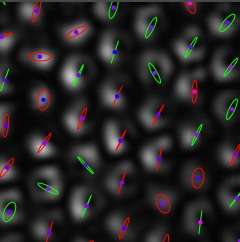A swift, economical technique for imaging multicore fibers in real time

Multicore fibers (MCF) have attracted much attention in the fields of telecommunications, fiber lasers and medical endoscopes. MCF-based optical imaging techniques, which use a fiber bundle (each fiber acting like a discrete pixel to form the final pixelated image), are useful for investigating inside the human body in a minimally invasive way. Recently, there has been a growing interest in applying MCFs for high-power laser amplifiers and next-generation lensless endoscopes for in-vivo cancer diagnosis, which requires the capability of measuring and controlling the spatial, temporal and polarization states of the output light in MCFs in real-time. This makes the production and fabrication of a truly disposable, low-cost and accurate endoscopy probe possible.
Now, researchers from Aix Marseille Université and Université Lille, both in France, in collaboration with optical scientists from the University of Rochester, New York, USA, have proposed a new technique.
The proposed method is fast, simple, inexpensive, and able to simultaneously measure polarization states of light through numerous fiber cores in real time. Unlike existing techniques that either require multiple steps or significant experimental complexity, this technique takes the measurement through a simple optical window, technically called a stress-engineered optical element (SEO), which encodes the polarization state of light into the spatial shape of the images of the individual fiber cores.
The proposed technique paves the way for controlling the light polarization state of multicore fibers, potentially enabling structural and molecular imaging in endoscopy. The researchers will present their work at the Frontiers in Optics (FiO) / Laser Science (LS) conference in Rochester, New York, USA on 17-21 October 2016.
"This is a powerful yet simple technique to examine the polarization evolution of light through fibers at a rate limited only by the camera," said Miguel Alonso, the primary researcher and an associate professor of optics at the University of Rochester. "To the best of our knowledge, this technique provides the first and fastest measurement of the polarization state of light traversing more than 100 independent fiber cores in a multicore fiber bundle. Meanwhile, this method allowed us to characterize how polarization is scrambled by the fibers, especially when the fibers are twisted or distorted. We found that the polarization state of light is surprisingly robust to manipulation of the fibers."
Being able to measure light polarization states of multiple fiber sources simultaneously in real time opens the door to the possibility of creating a feedback loop to control polarization in many applications. For example, both high-power laser amplifiers and lensless endoscopes rely on combining multiple laser beams with identical properties to generate highly intense and localized beams. Polarization is one of the critical properties in need of control to achieve high intensity of laser beams. Moreover, in optical imaging applications, MCF-based endoscopes must be bent and moved in the medical investigation process. The real-time monitoring of light polarization state of each fiber will allow scientists to control and correct fiber laser beams in time to achieve high resolution images.
"The key concept in our experiment is that the light polarization state can be converted into spatial shape on the image of each individual fiber," Alonso explained. The central conversion device is the SEO, a cylindrical glass window with very distinct polarization properties.
In the experiment, a SEO and a circular polarizer—an optical filter similar to those used in 3-D movies—are placed between a fiber bundle and a camera, as well as in front of the lens forming the fiber images. The SEO encodes the polarization state of the laser beam from each fiber into a specific spatial shape (called a point spread function), which is observed and recorded on the camera. With the unique spatial shape, the researchers can deduce the original polarization state of the laser beam in each fiber.
In the study, the researchers applied the technique to two types of multicore fibers: polarization maintaining multicore fibers and conventional fiber bundles composed of 475 fiber cores.
"A polarization maintaining multicore fiber keeps specific polarization as light propagates through the fiber cores, which serve as a control experiment. The 475 core fiber represents a case of unknown polarization states where we have zero knowledge," said Alonso. The researchers demonstrated the capability of the single-shot polarimetric technique in characterizing the two different types of multicore fibers.
"The major advantage of the technique is its simplicity and efficiency," Alonso noted. "Moreover, it requires relatively inexpensive and static components that can be easily integrated into any imaging system."
The researchers' next step is to extend the real-time measurement to the control of the polarization state, which would lead to application in the measurement and the coherent control of light matter interaction at the nanoscale.
More information: The presentation "Single-Shot Polarimetry Imaging of Multicore Fibers," by Miguel Alonso, will take place from on Friday, 21 October at the Grand Ballroom A, Radisson Hotel Rochester Riverside, Rochester, New York, USA. www.frontiersinoptics.org/
Provided by Optical Society of America




















